Exchange 2003 ActiveSync Fehlercodes
Diese Daten habe ich von http://blog.flaphead.dns2go.com/archive/2005/11/21/3202.aspx extrahiert, da Blogs sehr oft so schnell kommen wie sie verschwinden. Der Dank gebührt Paul für die Aufbereitung der Daten.
IIS Logging
Sehr oft können Sie schon im IISLOG Fehler finden.
2008-06-30 11:20:13 W3SVC1 10.0.1.1 POST
/Microsoft-Server-ActiveSync/default.eas User=fcarius&DeviceId=FDB....0F8&DeviceType=PocketPC&Cmd=FolderSync&
Log=V25_LdapC0_LdapL0_RpcC10_RpcL0_Ers1_Pk55_Error:InvalidPolicyKey_
443 msxfaq\fcarius 10.0.1.2 MSFT-PPC/5.1.3000 449 0 0
Es lohnt sich auch mal nach "Error:" zu suchen um z.B.
SyncCollisionDetected oder InvalidPolicyKey o.ä. zu finden
Folgende Fehler können beim Einsatz von Exchange ActiveSync Server auftreten.
| Fehlercode | Beschreibung |
|---|---|
DEV_errorcode |
Dieser Fehler stammt vom Gerät selbst und hat nichts mit dem Exchange Server zu tun. |
MIS_errorcode |
Ehe die Funktion Exchange ActiveSync Server Teil von Exchange geworden ist, gab es auch den Mobile Information Server. Diese Fehler sind vom MIS. |
SYNC_errorcode |
Diese Fehler stammen von Exchange 2003 ActiveSync Server und entsprechen meist dem MIS-Fehlern. |
HTTP_errorcode |
Diese Fehler sind oft durch die Verbindung oder den IIS selbst verursacht und weisen auf Fehler in der HTTP-Verbindung (Namensauflösung, SSL, Routing etc.) hin |
CONNMGR_errorcode |
Diese Fehler beziehen sich auf den Connection Manager auf dem PocketPC, quasi das Gegenstück zum RAS-Client auf einem Desktop. |
INTERNET_errorcode |
Auch auf dem Windows Mobile gerät gibt es so etwas wie einen "WinSock"-Treiber. Diese Fehler deuten auf Probleme an dieser Komponente hin. Meist können Sie dann auch nicht Surfen etc |
HEX errorcode |
Keine genauere Beschreibung der Fehler |
Jede Quelle liefert verschiedene Fehler, die Hinweise auf die eigentliche Störung liefern. Die meisten Fehler werden auf dem Pocket PC angezeigt. Einige finden sich im Eventlog oder den IIS Protokollen.
Windows Mobile Error
| 2002/2003 device error code | Windows Mobile error code | möglicher Grund | mögliche Lösung |
|---|---|---|---|
N/A |
85002000 |
Zuwenig Speicherplatz verfügbar. |
Löschen Sie nicht mehr benötigte Daten. |
N/A |
85002001 |
Ein nicht weiter bekannter Synchronisationsfehler ist aufgetreten. |
Versuchen Sie es später noch einmal. |
DEV-Errors
| 2002/2003 device error code | Windows Mobile error code | möglicher Grund | mögliche Lösung |
|---|---|---|---|
DEV_1 |
85002002 |
Zuwenig Speicher auf dem Gerät verfügbar. |
Löschen Sie überzählige Dateien und Mails vom Gerät |
DEV_1 |
N/A |
Synchronization failed. You do not have enough free memory on your device to synchronize information. Delete unused files from your device or close programs that are running to free up memory, and then try again |
The storage memory holds all the applications that are loaded in RAM on the device. The program memory is used by programs that are running. The shell adjusts allocation of storage and program memory. The shell will close applications to free program memory. You can also close applications manually by clicking Settings, System, Memory, Running Programs, and stopping the unnecessary applications. To free up storage memory remove unnecessary programs that have been loaded |
DEV_2 |
85002003 |
The device timed out while waiting to establish a connection with the server. |
Try again later. Ensure device is able to browse Internet sites. |
DEV_2 |
N/A |
Synchronization cannot be completed successfully due to a server time out. Disconnect, reconnect and try again. |
This error is reported when the server fails to respond to a command
sent from the device..
|
DEV_3 |
85002004 |
The User manually ended the synchronization process from the device. |
Try again. |
DEV_3 |
N/A |
You have stopped synchronization. |
This error is reported when you disconnect the connection that was being used für synchronization. für example, if you were using a CDPD modem für connectivity and you clicked on Disconnect in the middle of an ActiveSync
session, you could get this error. |
DEV_4 |
N/A |
Synchronization failed. If the problem continues, contact your network administrator |
This error is caused by corruption in the data store
|
DEV_6 |
85002007 |
The synchronization failed because of a problem on the server but no server-originated error codes (or any other unknown server errors) were received by the device. |
Verify that the server is available and supports synchronization with
a mobile device, and then try again later. Ensure the proper server name has been entered. |
DEV_7 |
85002008 |
An error occurred while ActiveSync was writing an item’s properties to the database on the device (per-item error). |
Try again. |
DEV_8 |
85002009 |
The synchronization key data on the device is not valid because a data removal failed. |
Try again. May require User to de-select sync items (Inbox, Contacts, Calendar, Tasks) and re-select them to reset the sync key. |
DEV_9 |
8500200A |
The required connection information is not present on the device. |
Verify the server information and credentials on the device. |
DEV_9 |
N/A |
The connection failed due to missing server information or User credentials. Tap Options, and then the Server tab to verify that your server name is correct. Then, tap Advanced to verify that your User credentials are correct and try again |
User Action:
|
DEV_10 |
8500200B |
The device timed out while waiting für a response from the server. |
Verify that the server is available and try again later. |
DEV_10 |
N/A |
Synchronization failed because the device timed out waiting für the server to respond. Try again later. |
This error is reported when the device times out while trying to establish
a connection with the server. The error is reported after around 4 minutes. |
DEV_11 |
8500200C |
The device could not shut down the send/receive thread after the User requested the synchronization to stop. The synchronization application on the device was forced to close. |
|
DEV_12 |
8500200D |
The device timed out while waiting für a response from the User. |
Try again. |
DEV_13 |
8500200E |
A failure occurred on the device that is not indicated to the User. |
|
DEV_14 |
8500200F |
The device timed out while waiting für a response from the server. |
Verify that the server is available and try again later. |
N/A |
85002010 |
The device’s last error is displayed. |
|
HTTP-Errors
| 2002/2003 device error code | Windows Mobile error code | möglicher Grund | mögliche Lösung |
|---|---|---|---|
HTTP |
85010000 |
An unknown HTTP communication or protocol error occurred. |
Ensure device is able to browse Internet sites. |
HTTP_400 |
85010001 |
An invalid HTTP communication or protocol syntax occurred.. |
|
HTTP_401 |
85010002 |
An unauthorized HTTP communication or protocol was used. |
The credentials provided to access the server are incorrect or you are
not enabled für synchronization or your password has expired.
|
HTTP_402 |
85010003 |
Payment is required für HTTP communication. |
|
HTTP_403 |
85010004 |
Die HTTP-Kommunikation ist verboten oder der Anwender darf nicht ActiveSync verwenden. |
mögliche Fehler
Im IISLog sollten Sie weitere Details sehen. |
HTTP_404 |
85010005 |
An object was not found by the HTTP communication or protocol. |
Verify that the object exists, and then try again. If this error occurs
again, remove the item from the synchronization list.
The server name specified on the device resolves to the IP address of
a server that does not have Exchange installed on it.
|
HTTP_405 |
85010006 |
The method is not allowed für use with an HTTP communication or protocol. |
Eventuell Content Filter der Firewall, welcher z.B. POST u.a. blockiert |
HTTP_406 |
85010007 |
No response acceptable to the client was found für HTTP communication or protocol to proceed.. |
Der Server konnte auf die Anfrage des Clients keine mögliche Aktion ausführen. |
HTTP_407 |
85010008 |
Proxy authentication is required für HTTP communication or protocol to proceed. |
Der Zugriff erfolgt über einen HTTP-Proxy, für den eine Anmeldung
erforderlich ist. |
HTTP_408 |
85010009 |
The server timed out while waiting für the request für an HTTP communication. This error occurs when a request is sent but never gets a response, typically in low signal conditions. Generally, it is a temporary or recoverable situation. |
Try again later. |
HTTP_409 |
8501000A |
The User should resubmit the HTTP communication with more information. |
Verify the information and settings associated with the HTTP communication and try again. |
HTTP_410 |
8501000B |
The HTTP resource is no longer available. |
Ensure the server is available. |
HTTP_411 |
8501000C |
The server refused to accept the HTTP communication request without a length. |
|
HTTP_412 |
8501000D |
The precondition given in the HTTP communication request failed. |
Verify Internet settings and try again. |
HTTP_413 |
8501000E |
The HTTP communication request entity was too large. |
|
HTTP_414 |
8501000F |
The requested HTTP universal Resource Identifier (URI) was too long. |
|
HTTP_415 |
85010010 |
An unsupported HTTP media type was used. |
|
HTTP_416 |
85010011 |
An HTTP communication or protocol error occurred. |
|
HTTP_417 |
85010012 |
An HTTP communication or protocol error occurred. |
|
HTTP_449 |
85010013 |
An HTTP communication or protocol error occurred. |
|
HTTP_500 |
85010014 |
An internal HTTP server error occurred. OR Synchronization failed due to an error on the server. Try again. |
Verify that the HTTP server is available and try again. May require User to de-select sync items (Inbox, Contacts, Calendar, Tasks) and re-select
them to reset the sync key.
User Action:
|
HTTP_501 |
85010015 |
The required protocol is not supported. |
|
HTTP_502 |
85010016 |
An error response was received from the HTTP gateway. |
Verify that the gateway is available and try again.
User Action:
|
HTTP_503 |
85010017 |
The device is temporarily overloaded. |
Try again later.
User Action:
|
HTTP_504 |
85010018 |
The device timed out while waiting für the HTTP gateway |
Try again later.
User Action:
|
HTTP_505 |
85010019 |
The HTTP version is not supported. |
|
HTTP_507 |
8501001A |
HTTP is out of disk space. |
|
CONNMGR-Errors
| 2002/2003 device error code | Windows Mobile error code | möglicher Grund | mögliche Lösung |
|---|---|---|---|
CONNMGR_0 |
85020000 |
The connection status is unknown in the Connection Manager. |
|
CONNMGR_16 |
85020001 |
The connection is open in the Connection Manager. |
|
CONNMGR_32 |
85020002 |
The connection is disconnected in the Connection Manager. |
|
CONNMGR_33 |
85020003 |
The connection failed and cannot be reestablished by the Connection
Manager. |
User Action:
|
CONNMGR_34 |
85020004 |
The User ended the connection. |
|
CONNMGR_35 |
85020005 |
The Connection Manager is ready to connect but the connection is disabled. |
|
CONNMGR_36 |
85020006 |
The Connection Manager could not find a path to the destination. |
User Action:
|
CONNMGR_37 |
85020007 |
The Connection Manager is waiting für a path to the destination. |
User Action:
|
CONNMGR_38 |
85020008 |
A voice call is in progress. |
Try synchronizing again after the voice call is finished. |
CONNMGR_64 |
85020009 |
The Connection Manager is attempting to connect. |
Ensure the device can access Internet sites. |
CONNMGR_65 |
8502000A |
Another connection is using the resource. |
Try again later. |
CONNMGR_66 |
8502000B |
The Connection Manager could not find a path to the destination. |
Ensure the device can access Internet sites. |
CONNMGR_128 |
8502000C |
The connection is being brought down. |
Ensure the device can access Internet sites. |
CONNMGR_129 |
8502000D |
The Connection Manager is stopping the attempt to connect. |
|
Sonstige Fehler
| 2002/2003 device error code | Windows Mobile error code | möglicher Grund | mögliche Lösung |
|---|---|---|---|
N/A |
85030000 |
No synchronization occurred while roaming. |
|
N/A |
85030001 |
The ActiveSync application is not supported. |
Upgrade the version of ActiveSync on the desktop computer and try again. |
N/A |
85030002 |
The ActiveSync application is not implemented. |
|
N/A |
85030003 |
No synchronization is scheduled in the ActiveSync application. |
|
N/A |
85030004 |
The ActiveSync application is not initialized. |
Restart the ActiveSync application and try again. |
N/A |
85030005 |
Mutex failed on the ActiveSync application. |
|
N/A |
85030006 |
The listview window in the ActiveSync application was not created. |
|
N/A |
85030007 |
The document was not sent in the synchronization context. |
|
N/A |
85030008 |
The synchronization document is not valid. |
|
N/A |
85030009 |
The proxy window in the ActiveSync application was not created. |
|
N/A |
8503000A |
The device failed to send a message to the ActiveSync application. |
|
N/A |
8503000B |
The ActiveSync application failed to start in a timely fashion. |
|
N/A |
8503000C |
The device failed to find the ActiveSync window. |
|
N/A |
8503000D |
The device failed to get the ActiveSync process handle. |
|
N/A |
8503000E |
The device failed to send the Extensible Markup Language (XML) document to the synchronization application. |
|
N/A |
8503000F |
An invalid collection type was used. |
|
N/A |
85030010 |
A DPA error occurred. |
|
N/A |
85030011 |
A POOM failure occurred. |
|
N/A |
85030012 |
A POOM Provider DSA error occurred. |
|
N/A |
85030013 |
No device address exists in the ActiveSync application. |
Verify that the device has an IP address and that it has a partnership with the desktop computer. |
N/A |
85030014 |
ActiveSync failed to configure the account to synchronize as new items arrive. |
Contact the Microsoft Exchange administrator. |
N/A |
85030015 |
The account could not be configured to synchronize as new items arrive. |
Select a different ActiveSync mobile schedule or contact the Microsoft Exchange administrator. |
N/A |
85030016 |
A silent retry error occurred in the ActiveSync application. |
|
N/A |
85030017 |
A retry level information error occurred in the ActiveSync application. |
|
N/A |
85030018 |
A retry level error occurred in the ActiveSync application. |
|
N/A |
85030019 |
The radio/phone is off. |
If using a Pocket PC device, try again after turning on the phone. |
N/A |
8503001A |
The response was compressed but had an invalid gzip header. |
|
N/A |
8503001B |
An error is returned by the zlib decompression function. |
|
|
85030022 |
|
|
INTERNET Fehler
| 2002/2003 device error code | Windows Mobile error code | möglicher Grund | mögliche Lösung |
|---|---|---|---|
INTERNET_1 |
0x80072F17 |
SSL Fehler |
Prüfen Sie das Datum auf dem Mobiltelefon. Vermutlich ist es in der Vergangenheit und das Zertifikat des Exchange Servers ist noch nicht gültig |
INTERNET_1 |
80072EE1 |
No more handles could be generated at this time. |
|
INTERNET_2 |
80072EE2 |
The request has timed out. It is generally a temporary or recoverable situation. |
Try again later. |
INTERNET_3 |
80072EE3 |
An extended error was returned from the server. This error is typically caused by a string or buffer containing a verbose error message. |
Retrieve the error text from the Verbose log file. |
INTERNET_4 |
80072EEC |
An internal error has occurred. It is generally a temporary or recoverable situation. |
Try again later. |
INTERNET_5 |
80072EE5 |
The uniform Resource Locator (URL) is invalid. This error is caused by a temporary server overload. |
Try again after verifying the URL. |
INTERNET_6 |
80072EE6 |
The URL scheme could not be recognized or is not supported. This situation is caused by temporary issues, such as insufficient temporary memory. |
Close one or more programs and try again. |
INTERNET_7 |
80072EE7 |
The server name could not be resolved. |
Verify the server name on the device and try again.
User Action:
|
INTERNET_8 |
80072EE8 |
The requested protocol could not be located. |
Verify that the protocol is supported by the device and by the desktop computer, and then try again. |
INTERNET_9 |
80072EE9 |
A request to InternetQueryOption or InternetSetOption specified an invalid option value. |
|
INTERNET_10 |
80072EEA |
The length of an option supplied to InternetQueryOption or InternetSetOption is incorrect für the type of option specified. |
|
INTERNET_11 |
80072EEB |
The request option cannot be set, only queried. |
|
INTERNET_12 |
80072EEC |
The Microsoft Win32® Internet function support is being shut down or unloaded. |
|
INTERNET_13 |
80072EED |
The request to connect and log on to a File Transfer Protocol (FTP) server could not be completed because the supplied User name is incorrect. |
Try again after verifying the server name and the User name. Also, try contacting the server administrator. |
INTERNET_14 |
80072EEE |
The request to connect and log on to an FTP server could not be completed because the supplied password is incorrect. |
Try again after verifying the server name, User name, and password. Also, try contacting the server administrator. |
INTERNET_15 |
80072EEF |
The request to connect to and log on to an FTP server failed. |
Try again after verifying the server name, User name, and password. Also, try contacting the server administrator. |
INTERNET_16 |
80072EF2 |
The requested operation is invalid. |
|
INTERNET_17 |
80072EF1 |
The operation was canceled, usually because the handle on which the request was operating was closed before the operation completed. |
|
INTERNET_18 |
80072EF2 |
The type of handle supplied is incorrect für this operation. |
|
INTERNET_19 |
80072EF3 |
The requested operation cannot be carried out because the handle supplied
is not in the correct state. Generally, this is a temporary and recoverable
situation. |
Try again later.
User Action:
|
INTERNET_20 |
80072EF4 |
The request cannot be made through a proxy. |
Change to a different type of connection and then try to reconnect to the synchronization resource. |
INTERNET_21 |
80072EF5 |
A required registry value could not be located. |
Verify the registry settings für ActiveSync, the mobile device, and the desktop computer. |
INTERNET_22 |
80072EF6 |
A required registry value was located but it is an incorrect type or has an invalid value. |
Verify the registry settings für ActiveSync, the mobile device, and the desktop computer. |
INTERNET_23 |
80072EF7 |
Direct network access cannot be made at this time. |
Verify that the network is available and that the User has permissions to access the network from a mobile device, and then try again later. |
INTERNET_24 |
80072EF8 |
An asynchronous request could not be made because a zero context value was supplied. |
|
INTERNET_25 |
80072EF9 |
An asynchronous request could not be made because a callback function has not been set. |
|
INTERNET_26 |
80072EFA |
The required operation could not be completed because one or more requests are pending. |
Try again later. |
INTERNET_27 |
80072EFB |
The format of the request is invalid. |
Verify the configuration settings für ActiveSync, the mobile device, and the desktop computer, and then try again later. |
INTERNET_28 |
80072FFC 80072EF4 |
The requested item could not be located. This error is similar to an “HTTP 404 Page Not Found” error in Internet Explorer. It may be caused by temporary server load conditions. |
Try again later. Ensure the device can access Internet sites. |
INTERNET_29 |
80072EFD |
The attempt to connect to the server failed because a connection to
the network was not detected. |
If using a desktop passthrough connection to synchronize to an ActiveSync
server, make sure that the device is in the cradle or otherwise connected
to the desktop computer. If using a wireless connection to the desktop computer,
verify that the connection settings are configured correctly.
Try again after verifying the server name, User name, and password. Also, try contacting the server administrator.
User Action:
|
INTERNET_30 |
80072EFE |
The connection with the server has been stopped. |
Verify that the server is available and try again. |
INTERNET_31 |
80072EFF |
The connection with the server has been reset. |
Verify that the server is listening on the SSL port and that the device
can connect to the server over SSL.
User Action:
|
INTERNET_32 |
80072F00 |
This error calls für the Win32 Internet function to redo the request. |
|
INTERNET_33 |
80072F01
80072EFC |
The request to the proxy was invalid. It may be caused by temporary load conditions. |
Verify proxy settings and try again later. |
INTERNET_36 |
80072F04 |
The request failed because the handle already exists. |
|
INTERNET_37 |
80072F05 |
The SSL certificate date that was received from the server indicates
that the certificate has expired. |
Verify that the date and time on the device are correct. If the date
and time are correct, then contact the server administrator to Update the
certificate.
User Action:
|
INTERNET_38 |
80072F06 |
The SSL certificate common name (host name field) is incorrect. |
Verify certificate settings.
User Action:
|
INTERNET_39 |
80072F07 |
The application is moving from a non-SSL to an SSL connection because of a redirection. |
|
INTERNET_40 |
80072F08 |
The application is moving from an SSL to a non-SSL connection because of a redirection. |
|
INTERNET_41 |
80072F09 |
The content is not entirely secure. Some of the content being viewed may have come from unsecured servers. |
|
INTERNET_42 |
80072F0A |
The application is posting and attempting to change multiple lines of text on a server that is not secure. |
|
INTERNET_43 |
80072F0B |
The application is posting data to a server that is not secure. |
|
INTERNET_44 |
N/A |
The server is requesting client authentication. |
Enter authentication credentials. |
INTERNET_45 |
80072F0D ? |
Synchronization failed. The security certificate on the server is invalid. Contact your system administrator or ISP to install a valid certificate on the server and try again. |
The sync client does certificate validation and has detected that an
invalid certificate is installed.
User Action:
|
INTERNET_55 |
80072F0D ? |
Synchronization failed. If the problem continues contact your Network Administrator |
The sync client does certificate validation and has detected that an
invalid certificate is installed.
User Action:
|
INTERNET_152 |
N/A |
Synchronization failed due to a communications failure. Try again. |
User Action:
|
INTERNET_150 |
80072F76 |
The requested header could not be located. |
|
INTERNET_151 |
80072F77 |
The server did not return any headers. |
|
INTERNET_153 |
80072F79 |
The supplied header was invalid. |
|
|
INTERNET_156 |
80072F7C |
The redirection failed because either the scheme changed (for example, HTTP to FTP) or all attempts made to redirect failed (default is five attempts). |
|
Sonstige Fehler
| 2002/2003 device error code | Windows Mobile error code | möglicher Grund | mögliche Lösung |
|---|---|---|---|
0x80042256 |
N/A |
Synchronization failed because the User aborted connection. |
User Action:
|
0x80070008 |
N/A |
: Synchronization failed. If the problem continues, contact your network administrator |
User Action:
|
0x8007000e |
N/A |
Synchronization failed. You do not have enough free memory on your device to synchronize information. Delete unused files from your device or close programs that are running to free up memory, and then try again. |
User Action:
|
0x80004005 |
N/A |
Synchronization failed due to a device software error. Contact your network administrator. |
User Action:
|
0x 80070057 |
N/A |
Synchronization failed. If the problem continues, contact your network administrator. |
User Action:
|
N/A |
N/A |
The phone is off. |
If using a Pocket PC device, try again after turning on the phone. |
N/A |
N/A |
The connection link disconnected prematurely. |
Verify that the resource is available and try again. |
N/A |
N/A |
The connection could not be established because it would split an exclusive connection. |
Wait until the exclusive connection is no longer being used, and then try again. Or cancel the current activity on the exclusive connection and then try again. |
N/A |
N/A |
The server or desktop computer failed to authenticate the User. |
Verify the User’s credentials. If the credentials are correct, verify that the User has permissions to synchronize with the server or desktop computer from a mobile device. |
MIS Fehler
| 2002/2003 device error code | Windows Mobile error code | möglicher Grund | mögliche Lösung |
|---|---|---|---|
MIS_3 |
N/A |
Sync key mismatch error. To restart sync, disable and re-enable Server ActiveSync on the device für the particular data type that failed (for example, Calendar, Contacts, or Inbox). |
User Action:
|
SYNC_3 |
N/A |
A critical error has occurred and sync failed. The next time you sync, you will be prompted to overwrite the data on your device with data from the server. You will lose only the changes made since your last successful sync. |
User Action:
|
MIS_5 / SYNC_5 |
N/A |
Synchronization failed due to a server software error. If the problem continues, contact your network administrator. |
User Action:
|
MIS_88 |
N/A |
Synchronization of <inbox> cannot be completed successfully. Your device must sync all inbox information with sync server. |
User Action:
|
MIS_9 |
N/A |
Synchronization failed. There is not enough space on your Microsoft Exchange mailbox to synchronize information. Delete old items to increase space and try again. |
User Action:
|
MIS_20 |
N/A |
A critical error has occurred and sync failed. When you next sync, you will be prompted to overwrite the data on your device with data from the server. This may take several minutes. |
User Action:
|
Weitere Links
- EAS Inside
- EAS Error Code
http://blog.flaphead.dns2go.com/archive/2005/11/21/3202.aspx - Informationen zur Fehlerbehebung in Microsoft® ActiveSync® 4.0 - KB
Article - 293205
http://support.dell.com/support/topics/global.aspx/support/kcs/document?c=br&l=pt&s=gen&docid=DSN_03A3392B4D254F87E0401E0A55173553&isLegacy=true&doclang=DE - Weitere Seite mit ActiveSync Fehlern
http://www.shijaz.com/exchange/activesync_errors.htm - 193625 INFO: WinInet Error Codes (12001 through 12156)
- http://msdn.Microsoft.com/library/en-us/wininet/wininet/wininet_reference.asp
- 330464 You may receive error messages on your PocketPC device or in the Nextags log when you synchronize your PocketPC device with Mobile Information Server 2002 or with Mobile Information 2001 Server
- 842541 You receive a "SYNC_5" or a "MIS_5" error message when you try to synchronize your Pocket PC or Smartphone calendar with your Exchange 2000 Server, Mobile Information Server 2002, or Exchange 2003 Server mailbox
- 915152 Information about Microsoft ActiveSync 4.0 error codes, error messages, and how to troubleshoot the error codes
- Errorcodes auf PocketPC FAQ
http://www.pocketpcfaq.com/faqs/activesync/exchange_errors.php - 905013 Enterprise firewall configuration für Exchange ActiveSync Direct Push Technology
- Palm: Article ID: 41731 using and managing certificates on Windows
Mobile smartphones
http://kb.palm.com/SRVS/CGI-BIN/WEBCGI.EXE?New,Kb=PalmSupportKB,ts=Palm_External2001,Case=obj(41820) - http://www.exchangeninjas.com/ExchangeActiveSyncProtocolLogging
-
Exchange: ActiveSync Fehlercodes
http://o-o-s.de/?p=451 - ActiveSync troubleshooting
http://www.pocketpcfaq.com/faqs/activesync/mis.htm - ActiveSync Errorcode
http://www.pocketpcfaq.com/faqs/activesync/exchange_errors.php
